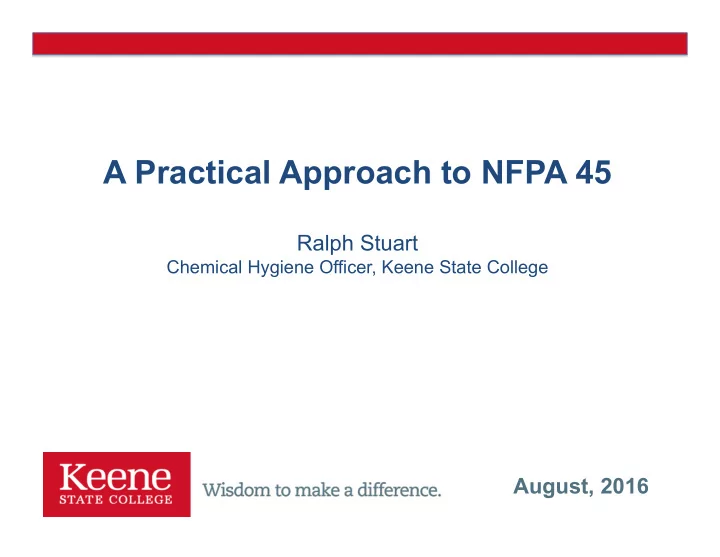

A Practical Approach to NFPA 45 Ralph Stuart Chemical Hygiene Officer, Keene State College August, 2016
Reviewing the methanol fire scenario 1. Replacing the Hazard 2. Engineering Controls: Fume Hood? 3. Training and Oversight 4. Personal Protective Equipment 5. Emergency Planning and Response Emergency Planning and Response
Are we doing better 8 years later? Recent demonstration methanol fires: 1. New York City, January 2014 2. Reno, Nevada, September 2014 3. Denver, Colorado, September 2014 4. Raymond, Illinois, October, 2014 5. Chicago, November, 2014 6. Tallahassee, Florida, May 2015 7. Washington, DC, October 30, 2015
The Challenge of Risk Assessment: Multiple Levels of Judgment Individual Expertise Review Required Identifying and Evaluating Guidance for Chartered Hazards in Research Accountants (CAs) in a Global Laboratories Economy
The Resulting Requirement: NFPA 45 Chapter 12, 2015 Instructor Responsibilities 1. Documented hazard risk assessment 2. Safety briefing for students prior to the start of each experiment to review the hazards of the chemicals used, the PPE required for the experiment, and review emergency procedures. 3. The Big Deal : These requirements are protocol specific, not a generic set of rules for lab classes
The Scope of NFPA Requirement • 3.3.13 Educational Laboratory Unit . … students through the twelfth grade … • 3.3.31 Instructional Laboratory Unit . … education past the 12th grade and before post-college graduate-level instruction … Experiments and tests conducted in instructional laboratory units are under the direct supervision of an instructor . • Laboratory units used for graduate or post-graduate research are not to be considered instructional laboratory units. • Instructor includes science teachers, assistant or associate professors, lecturers, substitute teachers, and teaching assistants
An Artist's Rendering of the Change A B So how do we move from A to B? Risk Assessment
Current Chemical Risk Assessment Education • Caveat emptor : Chemistry textbooks and laboratory manuals provide a overview of generic rules, followed by "see the MSDS". • For example, Wikipedia provides links to random MSDS sources; Linkrot is a serious problem some sources are kaput, many are dated.
The RAMP approach to Building a Lab Safety System Developing a Chemical Safety system involves addressing six elements: 1. EHS Culture 2. Hazard Identification 3. Risk Assessment 4. Managing Safety 5. Planning for Emergencies 6. Protecting the Environment From Stuart and McEwen. 2016
A Sample Procedure: CO 2 Tracer Gas Process Use fire extinguishers to raise CO 2 concentrations across the lab and then measure its decay in different locations.
The RAMP for CO 2 Release • Recognize hazards: CO2 exposures, noise, ergonomics, static electricity • Assess Risks (next page) • Manage Safety (next page) • Prepare for emergencies: monitor CO2 concentrations, don't work alone • Protect the Environment: CO2 is greener than solvents • Review Lessons Learned: improve the management system
Assessing Risks: CO 2 concentrations • General outdoor environment baseline: 400 ppm • Office spaces average between 600 and 800 ppm; comfort issues occur over 1000 ppm • OSHA PEL: 5000 ppm over 8 hours • Target for lab vent work: 10,000 ppm Atmospheric CO2 concentrations measured at • NIOSH IDLH: 40,000 ppm Mauna Loa Observatory from 1958 to 2015 Target concentration is 10,000 ppm for 5 minutes or less; we have hit 50,000 ppm
The Safety Management System For People: • CO 2 exposure : size the extinguisher(engineering) • Noise: wear hearing protection (PPE) • Electrostatic discharge: put the extinguisher on the floor (training) • Ergonomics: use carts (engineering) • Eye protection: dry ice flies everywhere (PPE) • Gloves: in case the hose leaks (emergency planning) For lab equipment and computers: Organic class lab, about 40 ACH • Dry Ice Spatter: Cover equipment to prevent dry ice from landing on it (engineering)
CO 2 RAMP and Bowtie Template available at http://dchas.org/bcce2016/ SOP Hazard Risk Bowtie Diagram Assessment
Scope of this Discussion • Included: – Laboratories operating at OSHA "lab scale" – Teaching labs in secondary or undergrad education (and some research labs) – Lab support includes faculty and staff who oversee the work • Not Included: – People who rely on the name of the chemical to determine the hazard (i.e. the public and emergency responders) – Complex research labs where process and hazards evolve unpredictably – Work with chemicals beyond OSHA lab scale
The Good News: Lab Safety is a Creative Process Safe Decision-Making Bloom's rests on 4 elements: Taxonomy Situational Awareness (adjusting to the unexpected) Creating Culture (behavior and Evaluating / rhetoric) Analyzing Education and Training (SOPs) Understanding / Applying Common Sense (Wiki-wisdom) Remembering
References 1. The Safety “Use Case”: Co-Developing Chemical Information Management and Laboratory Safety Skills, Stuart and McEwen, Journal of Chemical Education http://pubs.acs.org/doi/abs/10.1021/acs.jchemed.5b00511 2. Safety Data Sheets: Information that Could Save Your Life, Rohrig, ChemMatters Magazine. http://www.acs.org/content/acs/en/education/resources/ highschool/chemmatters/past-issues/2015-2016/ december-2015/safety-data-sheets.html 3. Assessing general ventilation effectiveness in the laboratory, Stuart, Sweet and Batchelder. Journal of Chemical Health & Safety, November/December, 2014 4. iRAMP Template available at http://dchas.org/bcce2016/
Recommend
More recommend